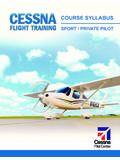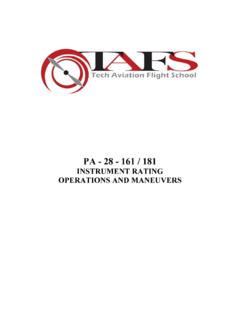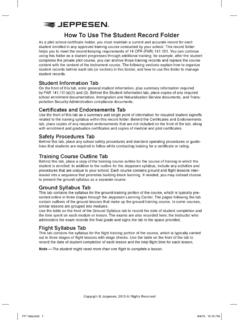Transcription of AOPA-UK NPPL (a)
1 The United Kingdom National private Pilot Licence (Simple Single-engine Aeroplane) (SSEA) syllabus Fourth Edition July 2011 Accepted AOPA syllabus for the UNITED KINGDOM National private Pilot Licence (Simple Single-engine Aeroplanes) Contents Page No. FOREWORD (iii) SECTION 1. Training objectives 1 INTRODUCTION Co-ordination of training 1 Summary of minimum training hours 1 Ground training 1 Definitions 1 Air exercises 2 Primary reference material 2 SECTION 2. Course objectives 3 NATIONAL private Course description 3 PILOT LICENCE Theoretical knowledge subjects 3 COURSE Flight training 4 Training aeroplanes 5 Training aerodromes 5 Theoretical Knowledge Examination 5 Navigation Skill Test and General Skill Test 5 SECTION 3.
2 Air Law 7 THEORETICAL Aeroplane General Knowledge 11 KNOWLEDGE Flight Performance and Planning 16 SUBJECTS Human Performance 17 Meteorology 19 Navigation 22 Operational Procedures 26 Principles of Flight 27 Communication 29 General Flight Safety 30 Theoretical Knowledge Examinations 31 (i) AOPA NPPL (SSEA) syllabus 8 July, 2011 SECTION 4. Flight training syllabus 32 FLIGHT TRAINING Flight briefings and air instruction 33 syllabus Solo navigation briefing certificate 40 Navigation Skill Test (NST) 42 NST Report Form 45 Qualifying cross country certificate 46 General Skill Test (GST) 47 Application and Report Form NPPL (SSEA) for the General Skill Test Application & Report Form 50 Summary of Exercises in Phases 1-4 51 Flying Hours Examples 52 Training Record Statements 53 (ii) AOPA NPPL (SSEA) syllabus 8 July, 2011 FOREWORD This syllabus , for the National private Pilot Licence Simple Single-engine Aeroplane (NPPL(SSEA))
3 Conforms to the agreed requirements of the United Kingdom Civil Aviation Authority (CAA) for the training of pilots for the grant of a UK National private Pilot Licence (SSEA). This syllabus is acceptable to the Authority. (iii) AOPA NPPL (SSEA) syllabus 8 July, 2011 SECTION 1 INTRODUCTION The purpose of this syllabus is to give guidance to instructors who are involved in the task of training pilots and to student pilots for the United Kingdom National private Pilot Licence Simple Single-engine Aeroplane. (NPPL (SSEA)). TRAINING OBJECTIVES Each course is to be designed so that the students or the pilots under training are given the experience, the competence in flying, and the knowledge of aviation technical matters demanded by the ground and flight tests as laid down in this syllabus for the initial issue of a National private Pilot Licence.
4 To enable them to use the aeroplanes and facilities of the private flying environment within the privileges of the licence, in a safe and responsible manner within their own limitations. CO-ORDINATION OF TRAINING The co-ordination of ground and flight training is a necessary and important part of any pilot course. Care should be exercised when conducting the course to ensure that flying training exercises are compatible with the student's ground training progress. SUMMARY OF MINIMUM TRAINING HOURS DUAL: hours to include: 1 hour instrument appreciation. SOLO: hours. TOTAL: hours -(Excluding Navigation Skill Test and General Skill Test) GROUND TRAINING This consists of all the theoretical knowledge required for the course.
5 No mandatory lecture periods are laid down and training may consist of directed self study. DEFINITIONS The following definitions provide a general guide to the briefings given, but may vary in length and content dependent on the individual students' needs. Long Briefing A detailed explanation and discussion conducted by the flight instructor of the major considerations of an air exercise. The normal length should be approximately 30 minutes and may be given to an individual student, or as an informal lecture to two or more students. Pre-flight Briefing A practical exposition by the flight instructor and lasting 10-15 minutes, on the contents of a specific flight lesson. This normally includes a statement of the aims, a brief revision of the practical aspects of any Principles of Flight involved, a 1 AOPA NPPL (SSEA) syllabus 8 July, 2011 statement of exactly what air exercises are to be taught by the instructor and practised by the student, and how, when and by whom the aeroplane is to be operated within the limits imposed by airmanship, weather and flight safety.
6 These limits may vary with a particular flight and will be appropriate to the student's stage of training. The order in which the content is given may vary according to the instructor's judgement and the student's experience. Post-flight Discussion A few minutes devoted by the instructor immediately after a specific lesson to consolidate the major points made during the flight, clarify any queries the student may have and review progress made by the student, using fault analysis or praise as necessary, and finally to indicate the nature of the next lesson. Theoretical Subjects The essential knowledge needed by students to comprehend the constraints of their intended operating environment and its inter-relationship with the operation of an aeroplane within their personal limitations.
7 The subject material may be covered by classroom lectures or by directed self study. Explanatory Note It should be appreciated that the wide coverage of theoretical subjects in the syllabus is due to the need for a student to develop a broad appreciation of the many factors concerned with the safe operation of aircraft, an appreciation which must be inculcated during training rather than afterwards. However, the need to have an "in depth" knowledge of the specified subject material will be confined to a limited number of items. AIR EXERCISES The numbering of the air exercises is to be used primarily as a reference list and instructional sequencing guide only. Demonstrations and practices need not necessarily be given in the order listed.
8 The actual order and content will depend upon the following interrelated factors: The student's progress and ability Instructional technique considerations The weather conditions affecting the flight The local operating environment. The flight time available PRIMARY REFERENCE MATERIAL National AIP and NOTAMS Aeronautical Information Circulars The Air Navigation Order LASORS CAP 413 - Radio Telephony Manual (latest edition) Aeronautical Charts 1:500,000 Ground Training Manuals -Trevor Thom volumes 1 - 5 Human Performance and Limitations (Campbell and Bagshaw) Aircraft Owners/Flight Manual/Pilot's Operating Handbook Safety Equipment - Manufacturers Recommendations and Instruction Leaflets Accident Information Bulletins General Aviation Safety Sense Leaflets ICAO Documents: Convention; Annexes 2, 7, 8, 11, 14; and Doc.
9 4444 2 AOPA NPPL (SSEA) syllabus 8 July, 2011 SECTION 2 NATIONAL private PILOT LICENCE Simple Single-engine Aeroplane (SSEA) Course COURSE OBJECTIVES The course shall be designed so that student pilots are given adequate theoretical knowledge and flight training in order to ensure they are capable of safely operating an aeroplane whilst flying in weather conditions appropriate to the visual flight rules. COURSE DESCRIPTION The course shall be undertaken at a Registered Facility (RF) or Flying Training Organisation (FTO) within the UK or Isle of Man and the required theoretical knowledge and flying training for the course is as follows: Theoretical Knowledge Subjects: The theoretical knowledge syllabus of the NPPL(SSEA) course shall cover the following: Air Law Aeroplane General Knowledge Flight Performance and Planning Human Performance and Limitations Meteorology Navigation Operational Procedures Principles of Flight Communications These subjects shall be covered by the use of lectures or by a course of directed study including self study at home.
10 Full details of the theoretical knowledge subjects are shown in Section 3 of this syllabus . 3 AOPA NPPL (SSEA) syllabus 8 July, 2011 Flight Training Flight instruction shall be given by flight instructors qualified in accordance with Joint Aviation Requirements-Flight Crew Licensing (JAR-FCL) and shall be sufficient to cover the following flight procedures and manoeuvres: pre-flight operations, including mass and balance determination, aeroplane inspection and servicing; aerodrome and traffic pattern operations, collision avoidance precautions and procedures; control of the aeroplane by external visual reference; flight at critically slow airspeeds; recognition of, and recovery from, incipient and full stalls; flight at critically high airspeeds; recognition of, and recovery from spiral dives.












